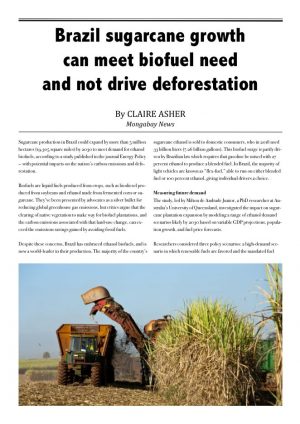 Sugarcane production in Brazil could expand by more than 5 million hectares (19,305 square miles) by 2030 to meet demand for ethanol biofuels, according to a study published in the journal Energy Policy — with potential impacts on the nation’s carbon emissions and deforestation.
Sugarcane production in Brazil could expand by more than 5 million hectares (19,305 square miles) by 2030 to meet demand for ethanol biofuels, according to a study published in the journal Energy Policy — with potential impacts on the nation’s carbon emissions and deforestation.
Biofuels are liquid fuels produced from crops, such as biodiesel produced from soybeans and ethanol made from fermented corn or sugarcane. They’ve been presented by advocates as a silver bullet for reducing global greenhouse gas emissions, but critics argue that the clearing of native vegetation to make way for biofuel plantations, and the carbon emissions associated with that land-use change, can exceed the emissions savings gained by avoiding fossil fuels.
Despite these concerns, Brazil has embraced ethanol biofuels, and is now a world-leader in their production. The majority of the country’s sugarcane ethanol is sold to domestic consumers, who in 2018 used 33 billion liters (7.26 billion gallons). This biofuel surge is partly driven by Brazilian law which requires that gasoline be mixed with 27 percent ethanol to produce a blended fuel. In Brazil, the majority of light vehicles are known as “flex-fuel,” able to run on either blended fuel or 100 percent ethanol, giving individual drivers a choice.
Measuring future demand
The study, led by Milton de Andrade Junior, a PhD researcher at Australia’s University of Queensland, investigated the impact on sugarcane plantation expansion by modeling a range of ethanol demand scenarios likely by 2030 based on variable GDP projections, population growth, and fuel price forecasts.
Researchers considered three policy scenarios: a high-demand scenario in which renewable fuels are favored and the mandated fuel blend increases to 35 percent ethanol; a low-demand scenario where fossil fuels are preferred and the mandate decreases to 20 percent ethanol; and a business-as-usual scenario where the blend remains steady at 27 percent. The authors predicted ethanol demand would increase by 17.5 million tonnes (of oil equivalent) in the fossil fuel scenario, and 34.4 million metric tonnes in the renewables scenario, representing an increase of 11 percent and 119 percent, respectively, over current levels of production. Policies favoring fossil fuels would lead to demand for 1.2 million hectares (4,633 square miles) of new sugarcane plantations by 2030, whereas renewables-focused policies would spur that expansion to 5 million hectares (19,305 square miles) — an area of new production roughly the size of Costa Rica.
David Lapola, an earth-system modeller at the University of Campinas in São Paulo state, not involved in the research, says he’s not surprised by the findings. “Of course, the demand for transport and the policies related to that … will affect the future demand,” he said. However, “the good thing is that they put that in numbers.”
Lapola does point to some uncertainties: ethanol isn’t the only possible product of sugarcane — harvested canes can also, for example, be processed into sugars for use in food — something he says the authors didn’t take into account. So even if Brazil’s domestic demand for ethanol subsides, sugarcane production may grow along with global demand for sugar.
Managing production to reduce emissions and deforestation
While sugarcane-based biofuels are typically dubbed as renewable, “whether ethanol use actually reduces greenhouse gas emissions depends on how the sugarcane is produced,” explains geoscientist Akenya Alkimim from the Universidade Federal de Vicosa in Minas Gerais, Brazil. Last year Alkimim reported the results of computer modeling, showing that for every hectare deforested in the Amazon, sugarcane plantations would release 608 tonnes of carbon dioxide into the atmosphere, creating a total “carbon debt” that would take 62 years of biofuel production to payback. So, she asks, “What would be the purpose of switching over to a ‘clean energy’ [renewable biofuel] if it would result in a higher overall carbon debt?”
However, if Brazil meets its rising sugarcane production needs not through new deforestation, but by converting existing pasture to cropland, that would release less than a tenth of the CO2 and take only six years to repay the carbon debt.
The need for intensified cattle ranching
Expansion of sugarcane into existing pasture could still indirectly drive increased carbon emissions if that land-use shift merely displaces cattle from already degraded grazing lands, causing ranchers to deforest elsewhere. In a 2010 study, Lapola estimated that sugarcane expansion could result in up to 52,000 square kilometers (20,077 square miles) of this kind of indirect deforestation by 2020, creating a carbon debt that would take 40 years to repay.
Thankfully, this worst case scenario has not been borne out. Instead, Lapola and colleagues have observed a different sequence of events: cattle ranchers giving up degraded pasture, tend to intensify land use by multiplying the number of cattle grazed per hectare elsewhere, a best use practice known as “increased stocking density” which minimizes new deforestation.
This land use intensification trend is predicted to continue in de Andrade Junior’s models, with increases in stocking density crucial to preventing sugarcane expansion from driving deforestation. “Since the stocking rates in Brazil are very low compared to their potential… higher pasture yields spare land for agriculture expansion without compromising beef and milk production,” said de Andrade Junior.
Accounting for changing government policies
In the present study, de Andrade Junior and his colleagues applied GLOBIOM-Brazil, a land use model created by Brazil’s to predict what types of land would bear the brunt of the projected sugarcane expansion. The team suggests that government fuel policies will have only a minor effect on future native vegetation loss, because all three study scenarios predicted that expansions would take place almost exclusively within pastures and not require new deforestation.
This is partly because the models included the Zoneamento Agroecologico de Cana-de-açúcar (ZAE CANA) — government zoning rules approved in 2009 that exclude federal subsidies for sugarcane producers in environmentally sensitive regions, including the Amazon and Pantanal wetlands. But on November 5, President Bolsonaro issued a decree revoking zoning regulations for the sugarcane industry, opening up the Amazon and other areas of primary forest to expanded cane cultivation. While the government claims the move is necessary to reduce bureaucracy and boost the ethanol industry, experts criticized the move, saying that opening up two extremely fragile biomes to sugarcane expansion is unjustifiable — and unneeded.
“Bolsonaro must understand that Brazil does not need to choose between conservation and economic development,” Alkimim explained.
Aline Soterroni, the modeling study’s co-author, described Bolsonaro’s move as “completely unnecessary … It is possible to meet a high demand for sugarcane ethanol in the coming years by expanding the sugarcane area over low productive pastures, and fully respecting the [zoning rules],” she said. ZAE CANA left around 60 million hectares (231,661 square miles) in Brazil outside the Amazon and Pantanal open to sugarcane cultivation — an area six times the extent of current sugarcane plantations in the country, and more than enough to meet even the highest demand scenario while avoiding primary forest.
The repeal came as a surprise for many, as it wasn’t apparently driven by industry pressure. Local industry representatives have previously rejected the idea as an unnecessary risk to the positive environmental reputation of the cane industry, which has historically distanced itself from Amazon deforestation.
In a statement published on the Brazilian Sugarcane Industry Association (UNICA) website, the organisation reaffirmed their commitment to the National Biofuel Policy (RenovaBio), a voluntary initiative that prohibits deforestation and rewards fuel producers that emit less carbon into the atmosphere with “decarbonization credits,” which is set to come into force in 2020. Experts hope that RenovaBio combined with the current Brazilian Forest Code, which mandates that 80 percent of privately owned land in the Legal Amazon must be conserved, will constrain sugarcane expansion to degraded pasture and other already existing agricultural land, despite the loss of ZAE regulations.
Staying within these areas serves industry interests because the Amazon and Pantanal ecosystems are poorly suited for cane cultivation and lack existing infrastructure to support new plantations. Areas elsewhere permitted by the now-revoked ZAE included the “most favorable soil and climate conditions for sugarcane crops in Brazil, so producers are naturally likely to favor those regions — regardless of the current political climate,” said de Andrade Junior.
“At least in the [next few years] it shouldn’t bring much difference to the sugarcane game,” agreed Lapola. “There [will be] no sugarcane plantation where there is no mill to process the harvest.”
Saving the Amazon to save face
In the longer term, it may not make economic sense for sugarcane producers to expand into the Amazon or Pantanal, because doing so could limit the export market. If even a fraction of Brazil’s bioethanol became associated with Amazon deforestation, the entire industry could be subject to boycotts at the consumer-, distributor- or national-level.
“The sugarcane industry doesn’t want to get involved in deforestation issues, so they might stay away from the region,” said Lapola.
Unlike corn ethanol produced in the U.S., which emits more greenhouse gases than it absorbs, sugarcane ethanol is accepted for import to the EU, Japan and other countries with strict import regulations, giving Brazil a competitive environmental advantage over other big biofuel producers. Amazon expansion could tip the balance on greenhouse gas emissions from sugarcane ethanol, making it hard to market as a renewable energy source and hampering Brazil’s own efforts to curb carbon emissions per the 2015 Paris Climate Agreement. Bolsonaro’s “decision may put this important commodity under risk of boycott, something that is not in the economic interest of the ethanol sector itself,” said Soterroni.
Bolsonaro’s ZAE decision a threat to cane industry?
Bolsonaro’s repeal of the ZAE coincides with the publication of greenhouse gas emissions statistics for 2018 by the greenhouse gas monitoring initiative Sistema de Estimativas de Emissões e Remoções de Gases de Efeito Estufa (SEEG).
The figures show that Brazil’s total greenhouse gas emissions remained stable in 2018 despite increasing deforestation, as a result of increasing bioethanol consumption, which reduced carbon emissions from the energy sector by 5 percent. However, dramatic increases in deforestation and forest fires seen in 2019 make it unlikely that the renewable energy sector can compensate for future surging emissions.
Alkimim suggests that this combination of factors may eventually lead the powerful Brazilian agricultural lobby, known as the bancada rurlista, to pressure Bolsonaro to reinstate ZAE to avoid tarnishing the industry’s renewable energy reputation. The President “will be forced to change his policies if they [negatively] affect Brazilian agribusiness.”
Thus, despite diminishing Amazon and Pantanal protections, ethanol biofuel production may yet turn out to be a practical means of meeting Brazil’s growing transportation demands, while avoiding forest loss and keeping carbon emissions low. “The conversion of pastures, especially degraded pastures, to ethanol production could be considered as a viable strategy for Brazil to combat GHG [greenhouse gas] emissions,” concluded Alkimim. But Lapola warns that liquid biofuels might soon lose their appeal: “I think the authors here, and probably everyone, are underestimating the speed at which hybrids and fully electric cars can dominate the market in the next decade or two.”
Claire Asher
Originally published
by news.mongabay.com
November 25, 2019





